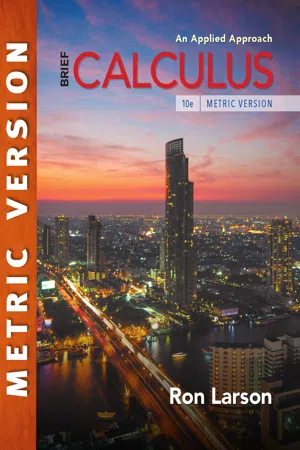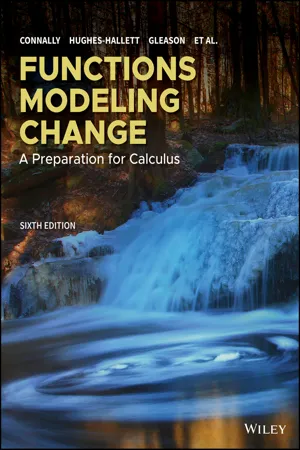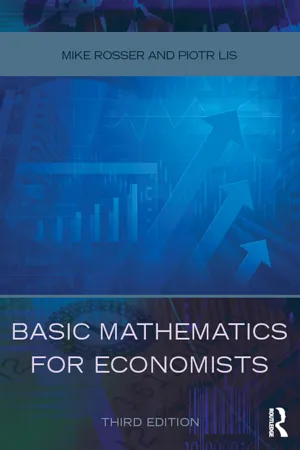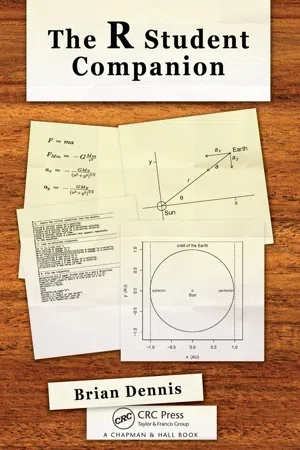Mathematics
Exponential Functions
Exponential functions are mathematical functions of the form f(x) = a^x, where the base "a" is a positive constant. These functions grow or decay at an increasingly rapid rate as x increases or decreases. They are characterized by their unique property of having a constant ratio between consecutive values, making them useful for modeling phenomena with exponential growth or decay.
Written by Perlego with AI-assistance
Related key terms
1 of 5
12 Key excerpts on "Exponential Functions"
- eBook - PDF
- Bernard Kolman, Arnold Shapiro(Authors)
- 2014(Publication Date)
- Academic Press(Publisher)
CHAPTER FOUR EXPONENTIAL AND LOGARITHMIC FUNCTIONS Thus far in our study of algebra we have dealt primarily with functions that are polynomials, or sums, differences, products, quotients, and powers of polynomials. In this chapter, we introduce a new type of function, the exponential function, and its inverse, the logarithmic function. Exponential Functions apply in nature and are useful in chemistry, biology, and economics, as well as in mathematics and engineering. We will study applications of Exponential Functions in calculating such quan-tities as compound interest and the growth rate of bacteria in a culture medium. Logarithms can be viewed as another way of writing exponents. Histori-cally, logarithms have been used to simplify calculations; in fact, the slide rule, a device long used by engineers, is based on logarithmic scales. In today's world of inexpensive hand calculators, the need for manipulating logarithms is reduced. The section on computing with logarithms will provide enough background to allow you to use this powerful tool but omits some of the detail found in older textbooks. 160 4.1 Exponential Functions 161 4.1 Exponential Functions The function f(x) = 2 X is very different from any of the functions we have worked with thus far. Previously, we defined functions by using the basic algebraic operations (addition, subtraction, multiplication, division, pow-ers, and roots). However, f(x) = 2 X has a variable in the exponent and doesn't fall into the class of algebraic functions. Rather, it is our first example of an exponential function. An exponential function has the form where a > 0, a # 1, The constant a is called the base, and the independent variable x may assume any real value. rhe simplest way to become familiar with Exponential Functions is to sketch their graphs. EXAMPLE 1 Sketch the graph of f(x) = 2 X . Solution We let y = 2 X and we form a table of values of x and y. - Ron Larson(Author)
- 2016(Publication Date)
- Cengage Learning EMEA(Publisher)
Exponential and Logarithmic Functions 4.1 Exponential Functions 4.2 Natural Exponential Functions 4.3 Derivatives of Exponential Functions 4.4 Logarithmic Functions 4.5 Derivatives of Logarithmic Functions 4.6 Exponential Growth and Decay 4 Balance t A 2 4 6 8 10 12 4 P 3 P 2 P P Time (in years) Continuously Compounded Interest A = Pe rt (12, 4 P ) (0, P ) (6, 2 P ) Example 3 on page 297 shows how an exponential growth model can be used to find the annual interest rate of an account. Ammentorp | Dreamstime.com Copyright 2018 Cengage Learning. All Rights Reserved. May not be copied, scanned, or duplicated, in whole or in part. WCN 02-300 252 Chapter 4 Exponential and Logarithmic Functions 4.1 Exponential Functions Use the properties of exponents to evaluate and simplify exponential expressions. Sketch the graphs of Exponential Functions. Exponential Functions You are already familiar with the behavior of algebraic functions such as f ( x ) = x 2 , g ( x ) = radical.alt2 x = x 1 H20862 2 , and h ( x ) = 1 x = x -1 each of which involves a variable raised to a constant power. By interchanging roles and raising a constant to a variable power, you obtain another important class of functions called Exponential Functions. Some examples are f ( x ) = 2 x , g ( x ) = parenleft.alt4 1 10 parenright.alt4 x = 1 10 x , and h ( x ) = 3 2 x = 9 x . In general, you can use any positive number a ≠ 1 as the base of an exponential function. Definition of Exponential Function If a > 0 and a ≠ 1, then the exponential function with base a is f ( x ) = a x . In the definition of an exponential function, the base a = 1 is excluded because it yields f ( x ) = 1 x = 1. This is a constant function, not an exponential function. When working with Exponential Functions, the properties of exponents, shown below, are useful. Properties of Exponents Let a and b be positive real numbers, and let x and y be real numbers. 1. a 0 = 1 2. a x a y = a x + y 3. a x a y = a x -y 4.- eBook - PDF
- Linda Almgren Kime, Judith Clark, Beverly K. Michael(Authors)
- 2018(Publication Date)
- Wiley(Publisher)
CHAPTER 5 Growth and Decay: An Introduction to Exponential Functions Overview Exponential and linear functions are used to describe quantities that change over time. Expo- nential functions represent quantities that are multiplied by a constant factor during each time period. Linear functions represent quantities to which a fixed amount is added (or subtracted) during each time period. Exponential Functions can model such diverse phenomena as bacteria growth, radioactive decay, compound interest rates, inflation, musical pitch, and family trees. After reading this chapter, you should be able to • recognize the properties of Exponential Functions and their graphs • understand the differences between exponential and linear growth • model growth and decay phenomena with Exponential Functions • represent Exponential Functions using percentages, factors, or rates • use semi-log plots to determine if data can be modeled by an exponential function • use base e to understand and model continuous or instantaneous compounding 255 5.1 Exponential Growth The Growth of E. coli Bacteria Measuring and predicting growth is of concern to population biologists, ecologists, demogra- phers, economists, and politicians alike. The growth of bacteria provides a simple model that scientists can generalize to describe the growth of other phenomena such as cells, countries, or capital. Bacteria are very tiny, single-celled organisms that are by far the most numerous organ- isms on Earth. One of the most frequently studied bacteria is E. coli, a rod-shaped bacterium approximately 10 −6 meter (or 1 micrometer) long that inhabits the intestinal tracts of humans and other mammals. 1 The cells of E. coli reproduce by a process called fission: The cell splits in half, forming two “daughter cells.” See course software “E2: Exponential Growth & Decay” for a dramatic visualization of growth and decay. Applet 1 Most types of E. coli are beneficial to humans, aiding in digestion. - eBook - PDF
- Cynthia Y. Young(Author)
- 2021(Publication Date)
- Wiley(Publisher)
Most of the functions (polynomial, rational, radical, etc.) we have studied thus far have been algebraic functions. Algebraic functions involve basic operations, powers, and roots. In this chapter, we discuss Exponential Functions and logarithmic functions, which are called transcendental functions because they transcend our ability to define them with a finite 424 CHAPTER 5 Exponential and Logarithmic Functions number of algebraic expressions. The following table illustrates the difference between algebraic functions and Exponential Functions. Function Variable is in the Constant is in the Example Example Algebraic Base Exponent f (x) = x 2 g (x) = x 1/3 Exponential Exponent Base F (x) = 2 x G(x) = ( 1 __ 3 ) x Exponential Function An exponential function with base b is denoted by f (x) = b x where b and x are any real numbers such that b > 0 and b ≠ 1. Note: • We eliminate b = 1 as a value for the base because it merely yields the constant function f (x) = 1 x = 1. • We eliminate negative values for b because they would give non–real-number values such as (−9) 1/2 = √ _ −9 = 3i. • We eliminate b = 0 because 0 x corresponds to an undefined value when x is negative. Sometimes the value of an exponential function for a specific argument can be found by inspection as an exact number. x −3 −1 0 1 3 F (x) = 2 x 2 −3 = 1 __ 2 3 = 1 __ 8 2 −1 = 1 __ 2 1 = 1 __ 2 2 0 = 1 2 1 = 2 2 3 = 8 If an exponential function cannot be evaluated exactly, then we find the decimal approximation using a calculator. Most calculators have either a base to a power button x y or a caret ⋀ button for working with exponents. x −2.7 − 4 _ 5 5 _ 7 2.7 F (x) = 2 x 2 −2.7 ≈ 0.154 2 −4/5 ≈ 0.574 2 5/7 ≈ 1.641 2 2.7 ≈ 6.498 The domain of Exponential Functions, f (x) = b x , is the set of all real numbers. It is important to note that in Chapter 0 we discussed exponents of the form b x , where x is an integer or a rational number. - eBook - PDF
- Ron Larson(Author)
- 2017(Publication Date)
- Cengage Learning EMEA(Publisher)
In this chapter, you will study two types of nonalgebraic functions—Exponential Functions and logarithmic functions. These functions are examples of transcendental functions. This section will focus on Exponential Functions. Definition of Exponential Function The exponential function f with base a is denoted by f (x) = a x where a > 0, a ≠ 1, and x is any real number. The base a of an exponential function cannot be 1 because a = 1 yields f (x) = 1 x = 1. This is a constant function, not an exponential function. You have evaluated a x for integer and rational values of x. For example, you know that 4 3 = 64 and 4 1H208622 = 2. However, to evaluate 4 x for any real number x, you need to interpret forms with irrational exponents. For the purposes of this text, it is sufficient to think of a radical.alt22 (where radical.alt22 ≈ 1.41421356) as the number that has the successively closer approximations a 1.4 , a 1.41 , a 1.414 , a 1.4142 , a 1.41421 , . . . . Evaluating Exponential Functions Use a calculator to evaluate each function at the given value of x. Function Value a. f (x) = 2 x x = -3.1 b. f (x) = 2 -x x = π c. f (x) = 0.6 x x = 3 2 Solution Function Value Calculator Keystrokes Display a. f (-3.1) = 2 -3.1 2 ^ (-) 3.1 ENTER 0.1166291 b. f (π ) = 2 -π 2 ^ (-) π ENTER 0.1133147 c. f ( 3 2 ) = (0.6) 3H208622 .6 ^ ( 3 ÷ 2 ) ENTER 0.4647580 Checkpoint Audio-video solution in English & Spanish at LarsonPrecalculus.com Use a calculator to evaluate f (x) = 8 -x at x = radical.alt22 . When evaluating Exponential Functions with a calculator, it may be necessary to enclose fractional exponents in parentheses. Some calculators do not correctly interpret an exponent that consists of an expression unless parentheses are used. Exponential Functions can help you model and solve real-life problems. For example, in Exercise 66 on page 368, you will use an exponential function to model the concentration of a drug in the bloodstream. - eBook - PDF
- Cynthia Y. Young(Author)
- 2023(Publication Date)
- Wiley(Publisher)
Most of the functions (polynomial, rational, radical, etc.) we have studied thus far have been algebraic functions. Algebraic functions involve basic operations, powers, and roots. In this chapter, we discuss Exponential Functions and logarithmic functions, which are called transcendental functions because they transcend our ability to define them with a finite 280 CHAPTER 3 Exponential and Logarithmic Functions number of algebraic expressions. The following table illustrates the difference between algebraic functions and Exponential Functions. Function Variable is in the Constant is in the Example Example Algebraic Base Exponent f (x) = x 2 g (x) = x 1/3 Exponential Exponent Base F (x) = 2 x G(x) = ( 1 __ 3 ) x Exponential Function An exponential function with base b is denoted by f (x) = b x where b and x are any real numbers such that b > 0 and b ≠ 1. Note: • We eliminate b = 1 as a value for the base because it merely yields the constant function f (x) = 1 x = 1. • We eliminate negative values for b because they would give non–real-number values such as (−9) 1/2 = √ _ −9 = 3i. • We eliminate b = 0 because 0 x corresponds to an undefined value when x is negative. Sometimes the value of an exponential function for a specific argument can be found by inspection as an exact number. x −3 −1 0 1 3 F (x) = 2 x 2 −3 = 1 __ 2 3 = 1 __ 8 2 −1 = 1 __ 2 1 = 1 __ 2 2 0 = 1 2 1 = 2 2 3 = 8 If an exponential function cannot be evaluated exactly, then we find the decimal approximation using a calculator. Most calculators have either a base to a power button x y or a caret ⋀ button for working with exponents. x −2.7 − 4 _ 5 5 _ 7 2.7 F (x) = 2 x 2 −2.7 ≈ 0.154 2 −4/5 ≈ 0.574 2 5/7 ≈ 1.641 2 2.7 ≈ 6.498 The domain of Exponential Functions, f (x) = b x , is the set of all real numbers. In Appendix A, we discussed exponents of the form b x , where x is an integer or a rational number. - eBook - PDF
Functions Modeling Change
A Preparation for Calculus
- Eric Connally, Deborah Hughes-Hallett, Andrew M. Gleason(Authors)
- 2019(Publication Date)
- Wiley(Publisher)
2. The independent variable in an exponential function is always found in the exponent. 3. If = 40(1.05) then is an exponential function of . 4. The following table shows a function that could be ex- ponential. 1 2 4 5 6 1 2 4 7 11 5. If your salary, , grows by 4% each year, then = 0 (0.04) where is in years. 6. If () = 4(2) then (2) = 64. 7. If () = 3( 2 5 ) then is a decreasing function. 8. If = () = 1000(0.5) then when = 125, = 3. 9. If = () = then is the initial value of . 10. If we are given two data points, we can find a linear function and an exponential function that go through these points. 11. A population that has 1000 members and decreases at 10% per year can be modeled as = 1000(0.10) . 12. A positive increasing exponential function always be- comes larger than any increasing linear function in the long run. 13. A possible formula for an exponential function that passes through the point (0, 1) and the point (2, 10) is = 4.5 + 1. 14. If a population increases by 50% each year, then in two years it increases by 100%. 15. In the formula = , the value of tells us where the graph crosses the -axis. 16. In the formula = , if > 1, the graph always rises as we read from left to right. 17. The symbol represents a constant whose value is ap- proximately 2.71828. 18. If () → as → ∞ we say that the line = is a horizontal asymptote. 19. Exponential graphs are always concave up. 20. If there are 110 grams of a substance initially and its decay rate is 3% per minute, then the amount after minutes is = 110(0.03) grams. 21. If a population had 200 members at time zero and was growing at 4% per year, then the population size after years can be expressed as = 200(1.04) . 22. If = 5 0.2 , we say the continuous growth rate of the function is 2%. 23. If = 4 −0.90 , we say the continuous growth rate of the function is 10%. - No longer available |Learn more
- Mike Rosser, Piotr Lis(Authors)
- 2016(Publication Date)
- Routledge(Publisher)
14 Exponential Functions, continuous growth and differential equations DOI: 10.4324/9781315641713-14Learning objectives
After completing this chapter students should be able to:- Use the exponential function and natural logarithms to derive the final sum, initial sum and growth rate when continuous growth takes place.
- Compare and contrast continuous and discrete growth rates.
- Set up and solve linear first-order differential equations.
- Use differential equation solutions to predict values in basic market and macroeconomic models.
- Comment on the stability of economic models where growth is continuous.
14.1 Continuous Growth and the Exponential Function
In Chapter 7 , growth was treated as a process taking place at discrete time intervals. In this chapter we shall analyse growth as a continuous process, but before we do this it is first necessary to understand the concepts of Exponential Functions and natural logarithms. The term ‘exponential function’ is usually used to describe the specific natural exponential function explained below. However, it can also be used to describe any function in the formaty =A xwhere A is a constant and A > 1This is known as an exponential function to base A. When x increases in value this function obviously increases in value very rapidly if A is a number significantly greater than 1. On the other hand, the value of Axapproaches zero if x takes on larger and larger negative values. For all values of A it can be deduced from the general rules for exponents (explained in Chapter 2 ) that A0 = 1 and A1 = A.Example 14.1
Find the values of y = Axwhen A is 2 and x takes the following values:- 0.5,
- 1,
- 3,
- 10,
- 0,
- −0.5,
- −1, and
- −3
Solutions
- A0.5 = 1.41
- A1 = 2
- A3 = 8
- A10 = 1024
- A0 = 1
- A−0.5 = 0.71
- A−1 = 0.50
- A−3 = 0.13
The natural exponential function
In mathematics there is a special number which yields several useful results when used as a base for an exponential function and is usually represented by the letter ‘e’. This number is - eBook - PDF
- Brian Dennis(Author)
- 2016(Publication Date)
- Chapman and Hall/CRC(Publisher)
e x p 170 The R Student Companion For instance, e xp − ⎛ ⎝ ⎜ ⎞ ⎠ ⎟ z 2 2 can be used instead of e − z 2 2 . Similar to trigonometric functions, the exponential function is a special preprogrammed function in R. The syntax is exp(x) , where x is a quantity or a vector of quantities. If x is a vector, the exponential function in R acts on each element of x and returns a corresponding vector of values. Go to the console and try it out: > x=1 > exp(x) [1] 2.718282 Raising e to the power 1 produces the (computer-approximate) value of e . Try more examples: > x=0:10 > exp(x) [1] 1.000000 2.718282 7.389056 20.085537 [5] 54.598150 148.413159 403.428793 1096.633158 [9] 2980.957987 8103.083928 22026.465795 > x=−(0:10) > exp(x) [1] 1.000000e+00 3.678794e−01 1.353353e−01 4.978707e−02 [5] 1.831564e−02 6.737947e−03 2.478752e−03 9.118820e−04 [9] 3.354626e−04 1.234098e−04 4.539993e−05 Remember that 3.678794e−01 in computer scientific notation means 3 6 7 8 7 9 4 1 0 1 . × − , which is the same as 0 36 7 8 7 9 4 . . The “ e ” in computer scientific notation stands for exponent, and not the number e . Exponential Growth We saw in a previous section (The Number e in Applications) that $1, invested at an annual interest rate r compounded continuously (e.g., daily, to an approximation) yields e r dollars after 1 year. After 2 years, there would be e e e r r r = 2 dollars, after 3 years there would be e e e e r r r r = 3 dollars, and so on. Evidently after t years the initial $1 would become e e r t rt ( ) = dollars. Here, t can be a real number too so that one can calculate the dollars after, say, 3 5 6 . years. 171 Exponential and Logarithmic Functions If instead of just one dollar there are m dollars initially and if we let n denote the number of dollars after time t , we arrive at the equation of expo-nential growth in continuous time: n m rt = e . In the exponential growth equation, m r e is the number of dollars in the investment after 1 year. - eBook - PDF
Applied Calculus for the Managerial, Life, and Social Sciences
A Brief Approach
- Soo Tan(Author)
- 2014(Publication Date)
- Cengage Learning EMEA(Publisher)
Due to electronic rights, some third party content may be suppressed from the eBook and/or eChapter(s). Editorial review has deemed that any suppressed content does not materially affect the overall learning experience. Cengage Learning reserves the right to remove additional content at any time if subsequent rights restrictions require it. 5.6 Exponential Functions AS MATHEMATICAL MODELS 399 5.6 Exercises 1. EXPONENTIAL GROWTH Given that a quantity Q 1 t 2 is described by the exponential growth function Q 1 t 2 5 300e 0.02t where t is measured in minutes, answer the following questions: a. What is the growth constant? b. What quantity is present initially? c. Complete the following table of values: t 0 10 20 100 1000 Q 2. EXPONENTIAL DECAY Given that a quantity Q 1 t 2 exhibiting exponential decay is described by the function Q 1 t 2 5 2000e 20.06t where t is measured in years, answer the following questions: a. What is the decay constant? b. What quantity is present initially? c. Complete the following table of values: t 0 5 10 20 100 Q 3. GROWTH OF BACTERIA The growth rate of the bacterium Escherichia coli, a common bacterium found in the human intestine, is proportional to its size. Under ideal laboratory conditions, when this bacterium is grown in a nutrient broth medium, the number of cells in a culture doubles approximately every 20 min. a. If the initial cell population is 100, determine the function Q 1 t 2 that expresses the exponential growth of the number of cells of this bacterium as a function of time t (in minutes). b. How long will it take for a colony of 100 cells to increase to a population of 1 million? c. If the initial cell population were 1000, how would this alter our model? 4. WORLD POPULATION The world population at the beginning of 1990 was 5.3 billion. - eBook - PDF
Algebra
Form and Function
- William G. McCallum, Eric Connally, Deborah Hughes-Hallett(Authors)
- 2015(Publication Date)
- Wiley(Publisher)
10 http://en.wikipedia.org/wiki/E_%28mathematical_constant%29, accessed June 11, 2007. 244 Chapter 6 Exponential Functions, EXPRESSIONS, AND EQUATIONS Writing Exponential Functions Using Base Example 1 on page 222 gives two equivalent ways of writing the value of an investment as an expo- nential function of time: = 4000 ⋅ 1.0595 This form emphasizes the investment’s annual growth rate. = 4000 ⋅ 2 ∕12 . This form emphasizes the investment’s doubling time. An important feature of an exponentially growing quantity, in addition to annual growth rate or its doubling time, is its continuous growth rate. For the investment described by Example 1 on page 222, it can be shown that the continuous growth rate is = 5.78% = 0.0578, and we can write = 4000 0.0578 . This form emphasizes the continuous growth rate. As different as these three formulas appear, they all describe the same underlying function, as we can see by writing 4000 ⋅ 2 ∕12 = 4000 ( 2 1∕12 ) = 4000 ⋅ 1.0595 so the first and second formulas are the same 4000 0.0578 = 4000 ( 0.0578 ) = 4000 ⋅ 1.0595 . so the first and third formulas are the same In the last step, we relied on the fact that ≈ 2.718: Using a calculator, 11 this gives 0.0578 = 2.718 0.0578 = 1.0595. Depending on the point we wish to make, we might prefer one of the three equations for to the others. The first one, having base = 1.0595, emphasizes the investment’s 5.95% annual growth rate, and the second, having base 2, emphasizes its doubling time of 12 years. The third, having base , emphasizes the continuous growth rate of 5.78%. In general: Any exponential function can be written in the form = ⋅ , and constants. Here, • is the initial value. • is the continuous growth rate. • Letting = , we can convert from base- form to standard form = ⋅ where is the growth factor. In Example 1, we see how to convert an exponential function given in base- form to standard form. - eBook - PDF
Intermediate Algebra
Connecting Concepts through Applications
- Mark Clark, Cynthia Anfinson(Authors)
- 2018(Publication Date)
- Cengage Learning EMEA(Publisher)
0, and b ? 1. ● The constant b is called the base of the exponential function. ● f 1 02 5 a, and thus, 1 0, a2 is the vertical intercept for the graph. ● Exponential growth and decay are two examples of exponential patterns that are found in the world. ● Exponential models occur when a quantity is being repeatedly multiplied by the same constant. ● When looking for an exponential pattern, try to find the quantity that is used repeatedly as the multiplier. Once found, it will help find the base b. A biologist is studying the growth of 50 Salmonella bacteria. Given the right food source and temperature range, these bacteria double in number every 15 minutes. a. Find an equation for a model for the number of Salmonella bacteria after h hours. b. Use the model to estimate the number of Salmonella bacteria after 3 hours. c. Estimate graphically when the number of Salmonella bacteria will reach 500,000. a. h 5 number of hours since starting with 50 Salmonella bacteria S1 h2 5 number of Salmonella bacteria Example 1 SOLUTION Exponential Functions: Patterns of Growth and Decay Section 5.1 Chapter Summary 5 Copyright 2019 Cengage Learning. All Rights Reserved. May not be copied, scanned, or duplicated, in whole or in part. Due to electronic rights, some third party content may be suppressed from the eBook and/or eChapter(s). Editorial review has deemed that any suppressed content does not materially affect the overall learning experience. Cengage Learning reserves the right to remove additional content at any time if subsequent rights restrictions require it. 535 C H A P T E R 5 S u m m a r y Because the bacteria double every 15 minutes, they double 4 times every hour. By building a table, we can find a pattern. h 0 1 2 3 h S(h) 50 50 1 2 2 4 50 1 2 2 8 50 1 2 2 12 50 1 2 2 4h From the pattern, we have the model S1 h2 5 501 22 4h . b. S1 32 5 501 22 4132 5 204800. After 3 hours, there will be about 204,800 Salmonella bacteria.
Index pages curate the most relevant extracts from our library of academic textbooks. They’ve been created using an in-house natural language model (NLM), each adding context and meaning to key research topics.











